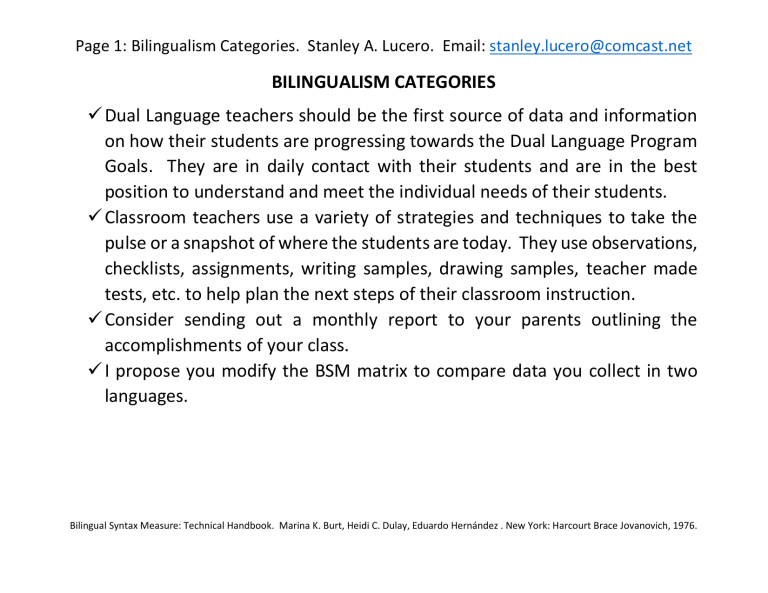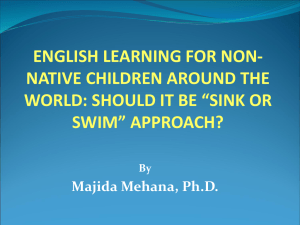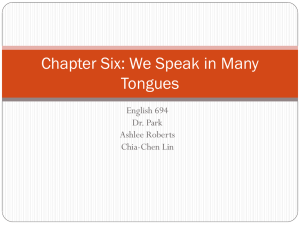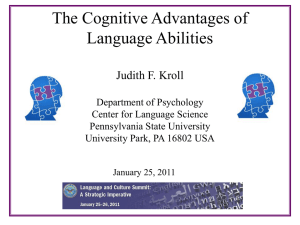BSM Matrix

Page 1: Bilingualism Categories. Stanley A. Lucero. Email: stanley.lucero@comcast.net
BILINGUALISM CATEGORIES
Dual Language teachers should be the first source of data and information on how their students are progressing towards the Dual Language Program
Goals. They are in daily contact with their students and are in the best position to understand and meet the individual needs of their students.
Classroom teachers use a variety of strategies and techniques to take the pulse or a snapshot of where the students are today. They use observations, checklists, assignments, writing samples, drawing samples, teacher made tests, etc. to help plan the next steps of their classroom instruction.
Consider sending out a monthly report to your parents outlining the accomplishments of your class.
I propose you modify the BSM matrix to compare data you collect in two languages.
Bilingual Syntax Measure: Technical Handbook. Marina K. Burt, Heidi C. Dulay, Eduardo Hernández . New York: Harcourt Brace Jovanovich, 1976.
Page 2: Bilingualism Categories. Stanley A. Lucero. Email: stanley.lucero@comcast.net
Suppose you had gathered the following information for your students and want to prepare a report for your parents. You report will not contain the names of any of your students. This data could be for listening, speaking, reading, writing, math, science, etc. in both English and
Spanish.
J
L
M
N
F
G
H
I
Student English Spanish
A 1 1
B
C
D
E
5
3
4
2
5
5
1
4
4
3
2
5
4
2
5
3
1
4
5
2
5
5
4
4
Bilingual Syntax Measure: Technical Handbook. Marina K. Burt, Heidi C. Dulay, Eduardo Hernández . New York: Harcourt Brace Jovanovich, 1976.
Page 3: Bilingualism Categories. Stanley A. Lucero. Email: stanley.lucero@comcast.net
ENGLISH
1 2 3 4 5
1
2
I
S
H
S
P
A
N
3
4
5
Bilingual Syntax Measure: Technical Handbook. Marina K. Burt, Heidi C. Dulay, Eduardo Hernández . New York: Harcourt Brace Jovanovich, 1976.
Page 4: Bilingualism Categories. Stanley A. Lucero. Email: stanley.lucero@comcast.net
• Understand and speak two languages at a high proficiency level.
• Be an active, participating member of two cultures.
Bilingual Bicultural
Bicognitive Biliterate
• Communicate your knowledge in two languages.
• Read and write two languages at a high proficiency level.
Bilingual Syntax Measure: Technical Handbook. Marina K. Burt, Heidi C. Dulay, Eduardo Hernández . New York: Harcourt Brace Jovanovich, 1976.
Page 5: Bilingualism Categories. Stanley A. Lucero. Email: stanley.lucero@comcast.net
Need more information Monolingual
Dominant
Bilingual
Balanced
Bilingual
Check Health records
Interview parents
Get developmental history
Was child sick and didn’t feel like responding?
Has there been a recent trauma?
Is there a cultural clash?
Try a variety of interventions in both languages.
If a student still has difficulties in both their home language and their second language, consider a referral to a student study team.
Most young children entering school are monolingual [preschool and kindergarten]
Students will remain monolingual until they are motivated to learn a second language.
Many English Learners reject their home language and culture around 3 rd -5 th grades and become monolingual in English.
By 2 nd or 3 rd grade students should be approaching bilingualism [listening, speaking, reading, and writing] but are still stronger in their first language
By 2 nd or 3 rd grade students can complete academic assignments in their first language but still need assistance when completing assignments in their second language.
By 5 th or 6 th grade, students should be able to understand, speak, read, and write two languages at grade level.
By 5 th or 6 th grade, students should be on grade level academically in two languages.
Students should also be active, participating members of two cultures
Bilingual Syntax Measure: Technical Handbook. Marina K. Burt, Heidi C. Dulay, Eduardo Hernández . New York: Harcourt Brace Jovanovich, 1976.
Page 6: Bilingualism Categories. Stanley A. Lucero. Email: stanley.lucero@comcast.net
Possible categories for the modified BSM matrix.
Decide which column is most appropriate for the data you have collected.
Level Percent Grade Description Group Other
1
2
3
4
5
0-19%
20-39%
40-59%
60-79%
F
D
C
B
80-100% A
No skills
Receptive
Well below average
Below average skills only
Survival skills Average
Above average Intermediate skills
Proficient skills
Advanced
Bilingual Syntax Measure: Technical Handbook. Marina K. Burt, Heidi C. Dulay, Eduardo Hernández . New York: Harcourt Brace Jovanovich, 1976.
Page 7: Bilingualism Categories. Stanley A. Lucero. Email: stanley.lucero@comcast.net
1 Spanish
2 Spanish
3 Spanish
4 Spanish
5 Spanish
1 English
Limited bilingual
1/1
Limited bilingual
2/1
Limited bilingual
3/1
Spanish monolingual
4/1
Spanish monolingual
5/1
2 English
Limited bilingual
1/2
Limited bilingual
2/2
Limited bilingual
3/2
Spanish monolingual
4/2
Spanish monolingual
5/2
3 English
Limited bilingual
1/3
Limited bilingual
2/3
Limited bilingual
3/3
Spanish dominant
4/3
Spanish dominant
5/3
4 English
English monolingual
1/4
English monolingual
2/4
English dominant
3/4
Intermediate balanced bilingual
4/4
Spanish dominant
5/4
5 English
English monolingual
1/5
English monolingual
2/5
English dominant
3/5
English dominant
4/5
Proficient balanced bilingual
5/5
Bilingual Syntax Measure: Technical Handbook. Marina K. Burt, Heidi C. Dulay, Eduardo Hernández . New York: Harcourt Brace Jovanovich, 1976.
Page 8: Bilingualism Categories. Stanley A. Lucero. Email: stanley.lucero@comcast.net
DATA
Observation
Checklist
SOLOM
Assignment
Writing assignment
What kind of data can you collect to determine bilingualism categories?
Which data works best for the following areas?
You must have data in two languages that are similar but not translated.
Listening Speaking Reading Writing Math Science Other
Bilingual Syntax Measure: Technical Handbook. Marina K. Burt, Heidi C. Dulay, Eduardo Hernández . New York: Harcourt Brace Jovanovich, 1976.






